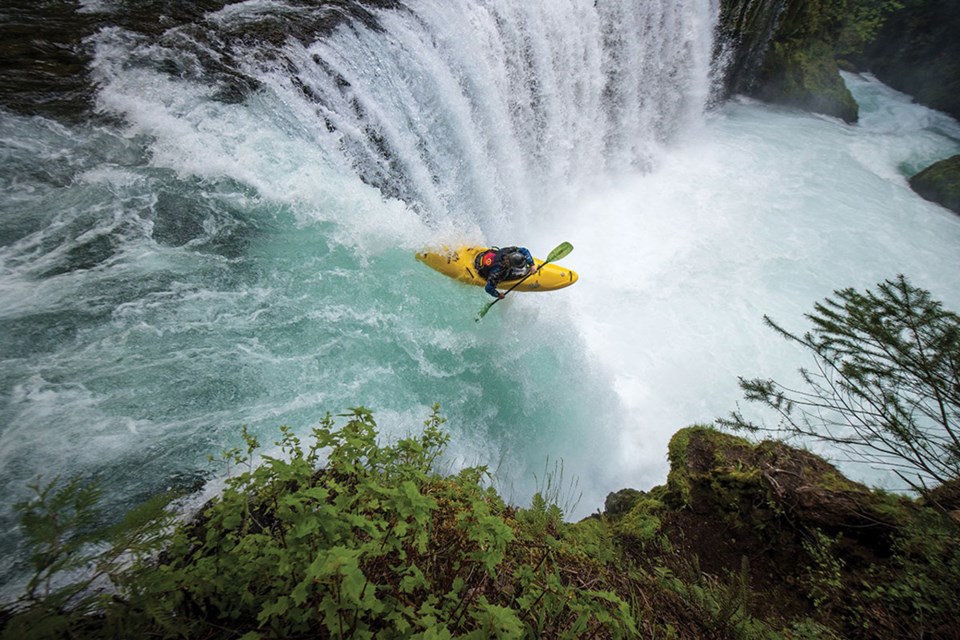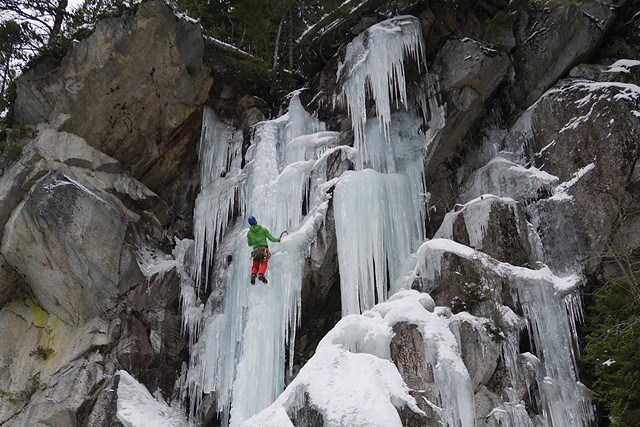There's a heart-pounding moment when Paul McSorley swings his axe into the last bit of cascading ice a few feet below the top of the Stawamus Chief. His breath hangs in the -4 Celsius air as he kicks his crampons into steps. A thick layer of snow drapes down from the top and McSorley stamps his axe through the crumbling powder, moving through the last few feet with ease, a lightness and energy to his step that matches his brimming excitement. In a few seconds he is at the top, and as he secures his anchor to begin belaying up his fellow climbers, he takes a moment to revel in what he has done: he's just made history as the first person to ice climb the entirety of the towering, 700-metre Chief.
"It was the highlight of the season and most of the ice climbers in town — all 12 of them — were watching this piece of ice," McSorley writes in an email.
It's not that no one has thought of ice climbing the Chief before; it's that there's never been enough ice to actually do it. The ice that does occasionally form is thin and brittle, at best, or buried under a foot of coastal snow. There have been many a story of sections of Squamish waterfalls crashing down either on climbers or while climbers are on them — which makes McSorley's first ice-climbing ascent up the Chief not only noteworthy, but downright ballsy.
It's the ballsy part that bumps ice climbing into the exclusive extreme sports club — a club marked by high risk and typically thought to involve only the reckless, most extreme thrill seekers addicted to the rush of adrenaline that comes with pushing the human body to its absolute edges.
Each of these sports places the athlete at a level of risk where the cost of failure is anything from paralysis to the ultimate price: death.
And even though they know the cost, for some participants, pushing their limits seemingly beyond reason is something they can't, or won't give up any time soon. While many of us fantasize about the kinds of jaw-dropping feats that wouldn't be out of place at the X Games or in a backcounty ski flick, McSorley, along with a handful of other athletes in the Sea to Sky Corridor, actually do them.
Ìý
Ìý
Ìý
And they do it almost every day.
But why?
Dr. Stephen Milstein, a Whistler psychologist, has seen his fair share of thrill seekers come through his door. He argues that extreme-sport participants like McSorley aren't in fact thrill seekers, but professionals who have made careful study of their sport and progressed to an elite level.
Thrill seekers, according to Milstein, are the ones who jump cliffs or recklessly huck jumps in the bike park.
"I find, at least in my practice, many of the people who are thrill seekers also are dissociative," he says, adding that disassociation is a state where the person experiences numbness, either physically or emotionally. "I think a lot of the people who are thrill seekers are just trying to feel. They're flat a lot of the time and they need that extra charge to get their endorphins."
It's that chemical surge that so many athletes can't seem to live without, although Milstein takes a different view on the addictive qualities of extreme sports.
"Addiction is something that is like, 'I can't stop and can't do without,'" he explains. "I don't know that (the endorphin rush) becomes addictive. Can some people get addicted to it? Sure. Does everybody? No."

On that particular January day last winter, McSorley and his partners climbed over 500 m, covering an unimaginable set of waterfalls. As it goes with all first ascents, the climbers didn't have the luxury of being able to follow an established route; they were the ones forging the path. They had known that the cascades near the top would be relatively solid, but it was unknown whether the lower parts were secure enough to hold.
It's that unknown, that sense of danger in a trying mountain environment, that makes McSorley tick. Top that with the reward of being the first up a route, and the temptation is almost irresistible.
"The draw of the first ascent or new route in ice is that it could only form once, ever," says McSorley. "There's something special about having the stars align and nabbing the first ascent of a new line."
When McSorley and his climbing partners reached the top of the Chief, they were undeniably excited. "I felt elated when I was topping out," McSorley recalls. "We were hooting and hollering with stoke."
McSorley doesn't view what he's doing as extreme, and that's perhaps a key insight into understanding why he and his three friends were the only ones ice-climbing the Chief that day last January.
"Ice is a bit ridiculous when you look at it from afar, but with good technique and a humble approach, it doesn't have to be extreme," he notes. "There are lots of variables in ice climbing but with a slow apprenticeship it can be a sustainable pursuit."
Ìý
from on .
McSorley's no stranger to the world of extreme sports. With almost 20 years of ice climbing under his belt, he's also an accomplished alpinist with first ascents in Patagonia and the Rockies. Six years ago he started paragliding. It is the quickest way to get down the mountain, after all.
And while it may seem like McSorley's penchant for risk-taking borders on recklessness, he sees it in a different light.
"I accept that risk is a big part of life and I try to make calculated decisions based on my often hard-won experience," he explains. "Without risk, life would be pretty lame.ÌýI certainly put myself in risky situations, but not without careful consideration."
In all his time on the rock and in the air, McSorley's never been critically injured. In fact, he's never taken a leader fall on ice — something he attributes to his deliberate risk management.
This story originally appeared in Pique Magazine, where you can find a that includes interviews with Edward Muggridge, Anna Segal, Brett Tippie and Tim Emmett.



